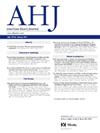Primary medication adherence in Medicare beneficiaries prescribed sacubitril-valsartan or renin-angiotensin system blockers for heart failure with reduced ejection fraction
IF 3.7
2区 医学
Q1 CARDIAC & CARDIOVASCULAR SYSTEMS
引用次数: 0
Abstract
Background
Sacubitril-valsartan is an angiotensin receptor-neprilysin inhibitor (ARNI) that is now preferred over angiotensin-converting enzyme inhibitors (ACE-Is) and angiotensin-II-receptor blockers (ARBs) for treating heart failure with reduced ejection fraction (HFrEF). Primary medication adherence to a costly brand-name ARNI, compared to inexpensive generic ACE-Is or ARBs, is unknown.
Methods
This cohort study used a linked database of electronic health records and Medicare fee-for-service claims from a large integrated health care system in Boston to compare primary medication adherence among Medicare beneficiaries with HFrEF newly prescribed sacubitril-valsartan, those newly prescribed a generic ACE-I or ARB, and those switching from an ACE-I or ARB to sacubitril-valsartan. The primary outcome was the proportion of individuals who filled their first prescription for any ARNI, ACE-I, or ARB within 90 days; a secondary outcome was the mean number of days to first fill. We used logistic regression to adjust for variations in patient characteristics, including demographics, comorbidities, medication use, and qualification for subsidized out-of-pocket prescription drug costs.
Results
Among 50 new sacubitril-valsartan prescription recipients, 33 (66%) demonstrated primary adherence at 90 days, compared to 141 of 231 (61%) new ACE-I or ARB prescription recipients (adjusted odds ratio 1.32, 95% CI, 0.63-2.73, P = .51). The mean time to first fill was 18 days for those prescribed sacubitril-valsartan and 9 days for those prescribed generic ACE-Is or ARBs (P < .001). By contrast, primary adherence at 90 days was higher (329 of 364, 90%) among those who switched from a generic ACE-I or ARB to newly prescribed sacubitril-valsartan.
Conclusions
In this small, single-center cohort study of Medicare beneficiaries with HFrEF, there was no difference in primary medication adherence among individuals newly prescribed sacubitril-valsartan and those newly prescribed generic ACE-Is or ARBs, although it took sacubitril-valsartan prescription recipients longer to fill their medication. Adherence was high among patients switching from an ACE-I or ARB to sacubitril-valsartan, suggesting that this switch was not associated with interruptions in renin-angiotensin blockade.
医疗保险受益人对射血分数降低的心力衰竭处方苏比替-缬沙坦或肾素-血管紧张素系统阻滞剂的主要药物依从性
背景:sacubitil -valsartan是一种血管紧张素受体-neprilysin抑制剂(ARNI),目前比血管紧张素转换酶抑制剂(ACE-Is)和血管紧张素- ii受体阻滞剂(ARBs)更适合用于治疗心力衰竭伴射血分数降低(HFrEF)。与便宜的非专利ACE-Is或arb相比,昂贵的品牌ARNI的主要药物依从性尚不清楚。方法:该队列研究使用来自波士顿大型综合医疗保健系统的电子健康记录和医疗保险按服务收费索赔的链接数据库,比较HFrEF新开萨比替-缬沙坦的医疗保险受益人,新开非专利ACE-I或ARB的医疗保险受益人以及从ACE-I或ARB切换到萨比替-缬沙坦的医疗保险受益人的主要药物依从性。主要结局是在90天内首次服用ARNI、ACE-I或ARB处方的个体比例;次要结果是首次填充的平均天数。我们使用逻辑回归来调整患者特征的变化,包括人口统计学、合并症、药物使用和自费补贴资格。结果:在50名新的苏比替-缬沙坦处方接受者中,33名(66%)在90天表现出最初的依从性,而231名新的ACE-I或ARB处方接受者中有141名(61%)表现出最初的依从性(校正优势比1.32,95% CI 0.63至2.73,p=0.51)。服用沙比替-缬沙坦的患者平均首次服药时间为18天,而服用非专利ACE-Is或arb的患者平均首次服药时间为9天(结论:在这项针对HFrEF医疗保险受益人的小型单中心队列研究中,新服用沙比替-缬沙坦的患者与新服用非专利ACE-Is或arb的患者在基本药物依从性方面没有差异,尽管服用沙比替-缬沙坦的患者服药时间更长。从ACE-I或ARB切换到苏比替-缬沙坦的患者依从性很高,表明这种切换与肾素-血管紧张素阻断的中断无关。
本文章由计算机程序翻译,如有差异,请以英文原文为准。
求助全文
约1分钟内获得全文
求助全文
来源期刊

American heart journal
医学-心血管系统
CiteScore
8.20
自引率
2.10%
发文量
214
审稿时长
38 days
期刊介绍:
The American Heart Journal will consider for publication suitable articles on topics pertaining to the broad discipline of cardiovascular disease. Our goal is to provide the reader primary investigation, scholarly review, and opinion concerning the practice of cardiovascular medicine. We especially encourage submission of 3 types of reports that are not frequently seen in cardiovascular journals: negative clinical studies, reports on study designs, and studies involving the organization of medical care. The Journal does not accept individual case reports or original articles involving bench laboratory or animal research.
 求助内容:
求助内容: 应助结果提醒方式:
应助结果提醒方式:


